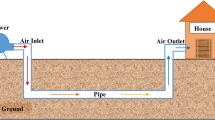Abstract
A new evaporative cooling system based on the action of centrifugal forces is proposed. Such systems are suitable for cooling large air volumes in tropical climates. Effects of geometrical and operational parameters on system performance are optimized using Taguchi method. It is observed that disc speed, air flow rate and water flow rate are found to have major influence on system performance and other parameter, viz., disc diameter, pin geometry, evaporation chamber length and orientation of pin have less influence.
Similar content being viewed by others
References
I.W. Eames, N.J. Marr and H. Sabir, “The evaporation coefficient of water: a review”, Int. J.Heat Mass Transfer, 40 (1997), pp.2963–2973.
W.K. Brown, “Application of evaporative cooling to large HVAC systems”, AHSRAE Trans., 102 (1996), pp.895–907.
R.G. Supple and B. Broughton, ’Indirect evaporative cooling-mechanical cooling design”, ASHRAE Trans., 91 (1985), pp.319–328.
Z. Giabaklou and J.A. Ballinger, “A passive evaporative cooling system by natural ventilation”, Building Environment, 31 (1996), pp.503–507.
H.J.M. Vollebregt and T. de Jong, “Indirect evaporative cooler with condensation of primary airflow”, ASHRAE Trans., 100 (1994), pp.354–359.
B.D. Hunn and J.L. Peterson, “Cost-effectiveness of indirect evaporative cooling for commercial buildings in Texas”, ASHRAE Trans., 102(1996), pp.434–447.
C.M. Scofield and N.H. Des Champs, “Indirect evaporative cooling using plate type heat exchangers”, ASHRAE Trans., 90 (1984), pp.148–153.
F.I. Al-Juwayhel, A.A. Al-Haddad, H.I. Shaban, and H.T.A. El-Dessouky, “Experimental investigation of the performance of two-stage evaporative cooler”, Heat Transfer Eng., 18 (1997), pp.21–33.
J.M. Wu, X. Huang and H. Zhang, “Theoretical analysis on heat and mass transfer in a direct evaporative cooler”, Applied Thermal Engineering, 29(2009), pp.980–984.
J.M. Wu, X. Huang and H. Zhang, “Numerical investigation on the heat and mass transfer in a direct evaporative cooler”, Applied Thermal Engineering, 29(2009), pp. 195–201.
A. Beshkani and R. Hosseini, “Numerical modeling of rigid media evaporative cooler”, Applied Thermal Engineering, 26(2006), pp.636–643.
Jose Rui Camargo, Carlos Daniel Ebinuma and Jose Luz Silveira, “Experimental performance of a direct evaporative cooler operating during summer in a Brazilian city”, International Journal of Refrigeration, 28(2005), pp. 1124–1132.
T. Gunhan, V. Demir and A.K. Yagcioglu, “Evaluation of the suitability of some local materials as cooling pads”, Biosystems Engineering, 96(3)(2007), pp.369–377.
Wojciech Zalewski, Beata Niezgoda-Zelasko and Marek Litwin, “Optimization of evaporative fluid coolers”, International Journal of Refrigeration, 23(2000), pp.553–565.
Zahra Ghiabaklou, “Thermal comfort prediction for a new passive cooling system”, Building and Environment, 38(2003), pp.883–891.
Metin Dagtekin, Cengiz Karaca and Yilmaz Yildiz, “Performance characteristics of a pad evaporative cooling system in a broiler house in a Mediterranean climate”, Biosystems Engineering, 103(2009), pp.100–104.
E.E. Anyanwu, “Design and measured performance of a porous evaporative cooler for preservation of fruits and vegetables”, Energy Conservation and Management, 45(2004), pp.2187–2195.
V.P. Sethi and S.K. Sharma, “Survey of cooling technologies for worldwide agricultural greenhouse applications”, Solar Energy, 81(2007), pp.1447–1459.
B. Costelloe and D. Finn, “Indirect evaporative cooling potential in air-water system in temperate climates”, Energy and Buildings, 35(2003), pp.573–591.
G.P. Maheshwari, F -Al -Ragom and R.K. Suri, “Energy-saving potential of an indirect evaporative cooler”, Applied Energy, 69(2001), pp.69–76.
Renato M. Lazzarin, “Introduction of a simple diagram-based method for analyzing evaporative cooling”, Applied Thermal Engineering, 27(2007), pp.2011–2025.
Dilip Jain, “Development and testing of two-stage evaporative cooler”, Building and Environment, 42(2007), pp.2549–2554.
B. Riangvilaikul and S. Kumar, “An experimental study of a novel dew point evaporative cooling system”, Energy and Buildings, 42 (2010), pp.637–644.
A.Z. Taha, A.A.A. Rahim, and OMM. Elton, Renew Energy, 5(1)(1994), pp.474–476.
J.R. Dossat, “Principles of refrigeration”, New York: John Wiley, (1981).
Dr. John R Watt, Evaporative Air Conditioning Hand book, New York: Chapman & Hall, (1986).
Ugur Esme, “Application of Taguchi method for the optimization of resistance spot welding process”, The Arabian Journal for Science and Engineering, 34(2009), pp.519–528.
Dale H. Besterfield, Carol Besterfield-Michna, Glen H. Besterfeild and Mary Besterfield-Sacre, “Total Quality Management”, Pearson Education Inc., New Jersey (2005).
P.J. Ross, “Taguchi Techniques for Quality Engineering”, 2nd ed, New York: McGraw-Hill, (1996).
Author information
Authors and Affiliations
Rights and permissions
About this article
Cite this article
Senthilkumar, K., Srinivasan, P. Application of Taguchi method for the optimization of system parameters of centrifugal evaporative air cooler. J. Therm. Sci. 19, 473–479 (2010). https://doi.org/10.1007/s11630-010-0411-z
Received:
Published:
Issue Date:
DOI: https://doi.org/10.1007/s11630-010-0411-z




